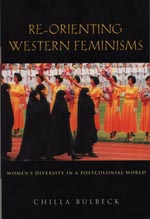-
Re-Orienting Western Feminism is a broad, deep and rigorous analysis which challenges the hegemony of white, Western feminisms. It critiques the East / West and Third World / First World divides along the lines of feminist politics. In the similar way to other postcolonial critics, Bulbeck writes that there is no pure East and West. However, whereas writers like Edward Said ignore issues of gender, and Gayatri Chakravorty Spivak focuses on class, Bulbeck extends notions of cultural hybridity into gender and class, beginning with a brief historical description of radical, liberal, and socialist feminisms.
-
Bulbeck examines the complex issues that surround different feminist perspectives or, rather, perspectives that challenge white, bourgeois, Western feminisms. The book provides a vast range of references, making it an extremely useful text. The 'Introduction' is a thumbnail sketch of all the many feminisms, locating Western feminism in the philosophical tradition of modernism, with its universalist claims on rationalist individualism. She writes that 'race-based oppression has supplanted class-based oppression as the critique of universal sisterhood.' However, the book also critiques the sort of narratives that bemoan the loss of past matriarchal glories as terribly interesting, as such stories are, aside from being patronising, largely unsupportable. Bulbeck deconstructs many key terms like masculinity, femininity, Western, Asian, Third World. She also deconstructs well-established assumptions, like the common belief that Westerners are individualistic and Asians are collectivistic.
-
Echoing Spivak's work on postcolonialism, Bulbeck traces how there are many different ways in which tradition and modernity are blended by women. And the political effect of colonistion on women in places like India, China and Japan, indicates that colonisation is not simply a two-step process from tradition to modernisation. For instance, India's colonial history shows how the position of women reflects Victorian notions of purity and domesticity, which derive from British occupation, as well as revived Indian traditionalism of women's special spirituality. Indian women did not, and do not, need British and American women's advice or support. To vindicate this claim, Bulbeck writes that today, 'more women are tenured at Delhi University than at Harvard.'
-
The theoretical backbone of the Re-Orienting Western Feminisms is a thorough critique of the sameness/difference debate. Often differences and similarities are not where we expect to find them. Bulbeck herself finds more in common (politically and in terms of personal style) with Chinese feminists than with North American feminists. She makes the point that different people in different places, or in the same place, have different positions on some important issues. This sort of analysis is applied to issues like clitoridectomy, surrogacy, and eugenics. For example, Bulbeck critiques Nawal el Sadaawi's position as being (possibly) critical of lower-class women-as-uninformed. In looking at global eugenics Bulbeck also explains how population policies often get refracted through a racist or a nationalist lens for Third World women and how social politics of motherhood are closely related to economics.
-
Bulbeck looks across cultures to see how masculinities as well as femininities are constructed, and she explores how male homosexuality is interpreted/constructed/lived across cultures. She writes that in Western cultures homosexual acts denote homosexual lives, while in some non-Western cultures men may perform homosexual acts without it being a threat to their heterosexual identity, and that the term 'gender identity' is far from universal. She also explores the apparently universal masculine fear of the monstrous-feminine.
-
Bulbeck also explores issues in women's rights and the law across cultures, and the various roles of women in paid and unpaid labour. She analyses the Universal Declaration of Human Rights and deconstructs its white, western male orientation. Indeed, the Universal Declaration of Human Rights 'is potentially less than universal.' For instance, many fourth world[1] women have to choose between rights to (white) national citizenship and community connections and obligations.
-
Re-Orienting Western Feminisms is an excellent critical analysis of political and social practices that shape how we interpret the world and especially the role of women in the world. It is a text which pushes and prods at the epistemological boundaries between East and West, and masculine and feminine identities.
Endnotes
[1] 'The fourth world consists of indigenous peoples in settler societies in North America and Australia, while the fifth world consists of migrants dispossessed of their heritage' (Kateryna O. Longley, 'Fifth World,' in Striking Chords: Multicultural Literary Interpretations, ed. Sonya Gunew and Katerina O. Longley, Sydney: Allen and Unwin, 1992, cited in Bulbeck, Re-Orienting Western Feminism, p. 35.

|

